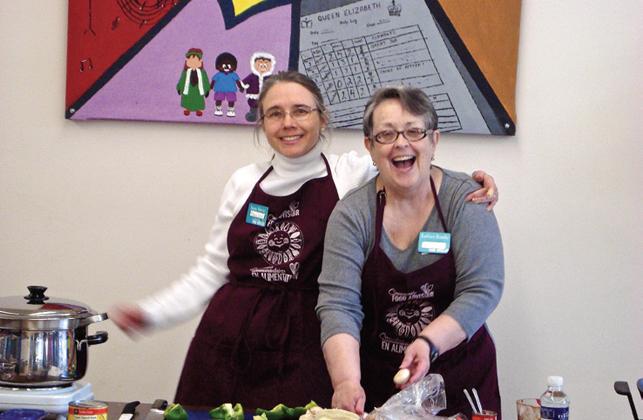
Cooking for Life
Our school, Queen Elizabeth P.S., is located in a low-income community. A number of our grade 8 students come to school without lunch, or they bring packaged convenience foods – less healthy choices.
To encourage our students to experience the wonderful taste of healthy food and to help them understand the value of home cooking, we decided to do a series of hot lunches. We applied for and received a grant from the Canadian Teachers’ Federation program Imagine action. When we undertook the “Cooking for Life” project with our three grade 8 classes in May, our school experienced a number of successes and firsts.
On the first day, public health nurse Christa Poirier visited each class and discussed healthy eating, reading labels, and looking for value in food choices. She also provided students with tools for making healthy choices as they shopped and planned meals.
We looked at Canada's Food Guide together and arrived at a consensus about a menu for our class to prepare. The students were excited about meal preparation, but planning was a new adventure for some. Religious, cultural, and personal concerns were discussed and honoured.
As we prepared our shopping list students had some interesting observations and questions:
“My mom always buys that, now I know what it is!”
“How can we make this a vegetarian option?”
“I'm allergic to dairy. Can we still make a smoothie?”
On the second day, the manager of the local supermarket took each class on a tour of the store. He introduced students to the areas most consumers don't see and explained how the store works. We discussed the layout of the store and what attracted their attention, and did cost comparisons of various items.
The class was divided into three teams; each team would prepare one part of the meal. Each team found the items it needed, compared costs, looked at ingredients, debated the nutritional values, and discussed product labels. They made wise choices and their smiles told us they felt successful in this venture.
On day three, two community food advisors from the Ottawa Public Health Department demonstrated a progressive menu from one original recipe: students learned how to transform a delicious tomato pasta sauce into a meat sauce, or chili, or nacho topping, or vegetarian pasta casserole.
The demonstration included tips on chopping and washing vegetables, maintaining a clean and healthy cooking environment, and saving money shopping. It also included smiles, good food, and laughter. Students participated in the demonstration, asked questions, answered questions, and tasted three versions of the recipe.
After the demonstration, each group started making its part of their own meal. Picture three student groups cooking in three different areas of the school; delicious smells, and sounds of cooking together and laughter, flooded the hallways. Within an hour, we started to attract visitors.
“What is that smell?”
“Ooooo, can I be in your class today?”
“Grade 8s are so lucky! I can't wait to be in grade 8!”
Finally it was time to eat! Students were proud and excited as they wheeled their part of the meal into the classroom. The other grade 8 classes were invited to taste our wonderful creation. When the bell rang for recess no one left.
All three grade 8 classes participated in this three-day program – so for three weeks we had menus, meal planning, label reading, and nutrition talk in the halls, lunchroom, and classrooms. About half way through we decided that this activity should be a regular part of our grade 8 programming. As a finale we organized a celebration dinner for parents, guardians, and siblings, with each class preparing one part of the meal. Visitors were also able to view a showcase of student work. Thanks to CTF and Imagine action for making this idea a reality.
